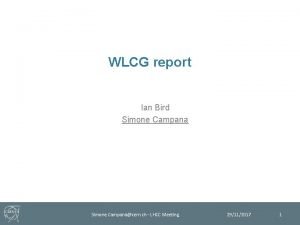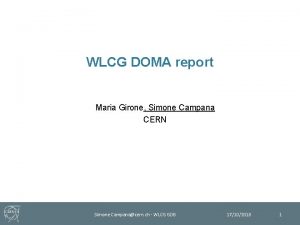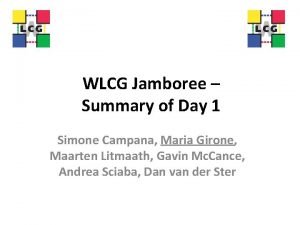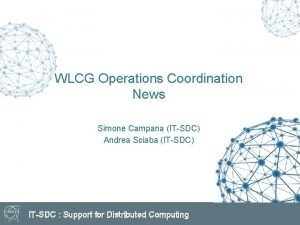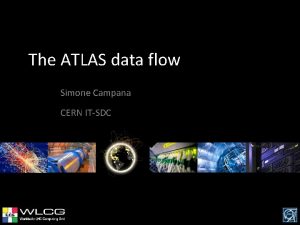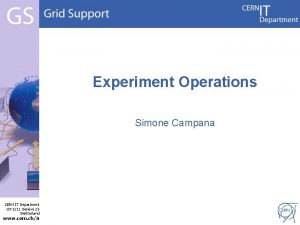The WLCG data Lakes Simone Campana CERN Thanks











- Slides: 11

The WLCG data Lakes Simone Campana (CERN) Thanks for the invitation. I would love to be there in person, but unfortunately I could not make it this time. I’ll try harder next time if I have the opportunity Simone. Campana@cern. ch - OSG AHM 2018 19/03/2018 1

WLCG needs manage and contain the cost of HL-LHC computing The cost comes both in terms of hardware (left) and operations § Storage today is the major hardware cost in most countries. Disk costs 4 x more than tape per TB § Storage is also the main operational cost at sites according to a recent (2015) survey Facts: Simone. Campana@cern. ch - OSG AHM 2018 19/03/2018 2

NB of bytes read (Pan. DA jobs) in 2017 1 Exabyte NB of bytes currently stored 138 PB primary on disk 136 PB custodial on tape secondary (disk+tape) Facts and Opinions: § LHC data is rather “cold”. E. g. Pan. DA jobs access 1. 4 EB/year of data (**). There are 165 PB of data on pledged disk (and 172 PB on tape). Each file on disk is accessed O(10) times. § Most of the data is accessed in a scheduled way (reconstruction/derivations). Data access patterns are extremely workflow dependent (**) Actually, less than that, as not the full event information is accessed Simone. Campana@cern. ch - OSG AHM 2018 19/03/2018 3

Evolution of Data and Compute Infrastructures High Level Services Data (Lake) Infrastructure Storage Interoperability Services Distributed Regional Storage Asynchronous Data Transfer Distributed Storage Volatile Storage Compute Infrastructure Content Delivering and Caching Grid Compute Cloud Compute HPC Compute @HOME Grid Compute Provisioning Site A Site B Simone. Campana@cern. ch - OSG AHM 2018 19/03/2018 4

Cost Model and Metrics Before/while we start prototyping any change in the infrastructure, services, computing models, we need the following: § A cost model, telling us if what we are doing is really going to reduce cost. Ø There is a WLCG working group on this § An understanding of which workflows we should be looking at and which metrics characterize them Ø Regular meetings between ATLAS and IT-WLCG for this purpose § A set of tools to measure those metrics Ø Tools such as Hammercloud Monitoring and Analytics do exist Ø We need to make sure they can do what we need Ø There is work ongoing on that as well Simone. Campana@cern. ch - OSG AHM 2018 19/03/2018 5

Storage Consolidation § We have of course experience with distributed storage instances under the same administrative domain (NDGF, CERN, AGLT 2. . ) High Level Services For different storage solutions we need prototypes to understand cost and Storage Interoperability Services benefits of the distributed nature: Data (Lake) Infrastructure § High Level Services Distributed Regional Storage Asynchronous Data Transfer Distributed Storage Volatile Storage Compute Infrastructure Content Delivering and Caching Ø Ø Ø Grid the cost saving in terms of operational Quantify (from sites, experiments) Cloud manpower. HPC Grid @HOME Grid Compute Quantify the cost saving in terms of hardware (hw vs sw redundancy, data lifecycle, …)Compute Evaluate how to integrate different classes of storage (e. g. volatile) Compute Provisioning Evaluate on the Site A the impact. Site B quality of service (self recovery, …) Evaluate the impact of latency of different workflows Simone. Campana@cern. ch - OSG AHM 2018 19/03/2018 6

Storage Interoperability § Very unlikely we will end up with one distributed storage spanning all WLCG. High Level Services Storages will need to interoperate. A similar model to Amazon’s regions. Data (Lake) Infrastructure Storage Interoperability Services Distributed Regional Storage Asynchronous Data Transfer Distributed Storage Volatile Storage Content Delivering and Caching We need to understand how to obtain the benefits in the previous slide, in this regional model. Develop the required services Grid Cloud HPC Grid @HOME Grid Compute Compute Infrastructure § § Compute We will need to asynchronously exchange large volumes of data across regions. Ø Ø Ø Compute Provisioning Evolution of File Transfer Systems 3 rd party transfer protocols and a different Authentication/Authorization model How to shape networks within the storage and between storages Site A Site B Simone. Campana@cern. ch - OSG AHM 2018 19/03/2018 7

Interfaces High Level Services Data (Lake) Infrastructure Storage Interoperability Services Distributed Regional Storage Asynchronous Data Transfer Distributed Storage Volatile Storage Content Delivering and Caching Commonalities at the level of the high level services will be the key of simplification Compute Infrastructure § § § Grid Compute Cloud HPC @HOME Grid Compute Ideally we would have one Data Management and one Workflow Management system Grid Compute Provisioning Realistically, implement the main functionalities in common services and rely on a thin Sitewe. Ashould try to. Site B specific layer on top of it Simone. Campana@cern. ch - OSG AHM 2018 19/03/2018 8

Content Delivery and Caching § Content delivery will be one of the key aspects to hide latency. Caching High Level Services is part of this Data (Lake) Infrastructure Storage Interoperability Services Distributed Regional Storage Asynchronous Data Transfer Distributed Storage Volatile Storage Compute Infrastructure Content Delivering and Caching Grid Compute Cloud Compute HPC Compute @HOME Grid Compute Provisioning Site A Site B Simone. Campana@cern. ch - OSG AHM 2018 19/03/2018 9

Content Delivery and Caching § Evaluate different caching technologies and methodologies Ø Caching needs to be workflow aware and workflows need to be cache aware § Work needs to be done in the area of organized data processing from archival media Ø How to efficiently store data to facilitate recall Ø How to schedule recalls based on the workflow and how to organize the workload based on the recalls Ø Understand how the archival storage technologies need to evolve and at which scale of resources § Data organization (datasets), storage (files) and processing (sub-events) work at different granularities. Leverage that rather than suffer from that Ø Interesting prototype suggested by UChicago. Decouples storage and compute representation of data. Refer to Rob/Iljia Simone. Campana@cern. ch - OSG AHM 2018 19/03/2018 10

Conclusions § The solution to the storage problem in HL-LHC is very simple: Ø Consolidate storage in few administrative domains and reduce operation/hardware cost Ø Store everything on archive media and recover the factor 4 in cost Ø Stage the data in an organized campaigns on little but very fast disk Ø Through a reliable content delivery system hide the impact of latency § In fact, this requires a lot of R&D work in the next couple of years. Ø Some areas are more R (“understand”) and some areas are more D (“prototype”) § We plan to organize a WLCG project covering all aspects above, to organize the discussion and measure the progress. TBD in Napoli next week. Simone. Campana@cern. ch - OSG AHM 2018 19/03/2018 11












